If you want to learn how to grow the most beautiful orchids possible, but aren’t even sure of where to start, then this is the guide for you.
As well as a thorough look at the basics, we’ll also introduce you to the best resources on the web and towards the end of the guide we’ll even touch on some advanced topics.
Growing orchids is a rewarding hobby and numbers of growers around the world seem to only increase year on year.
However, it’s an activity that can be daunting to get into. There are about 28,000 different varieties of orchid, each with varying requirements, so it’s not a surprise that many find it a little intimidating.
But, we’re here to help! It’s our aim to take out the frustration of learning about growing orchids by presenting you with a guide that teaches you everything you don’t know.
We might not be able to turn you into an award winning grower overnight, but by absorbing the information contained below and learning more from our recommended resources, we hope that we can at least put you on the right path to success.
Table of Contents
Part 1: The (surprisingly interesting) History of Orchids
Humans have long been interested in orchids. The earliest mention of orchids historically dates back to 700 BC in Chinese literature. At that time in China, orchids were mostly used for their medicinal properties.
In the West, our history with orchids is almost as old. In Greece in around 300 BC, Theophratus (a student of Aristotle) wrote about them and it’s from the Greek language that we get the name Orchid.
Fast forward almost a couple of millenia to the year 1810 and the encyclopaedia londinensis, the universal dictionary of art and sciences at the time, reported that while many orchids had been imported into Britain from the Americas, they were notoriously difficult to cultivate successfully.
A couple of decades earlier, Kew botanists had finally managed to get a cockleshell orchid to bloom for the first time. When news of this achievement spread, enthusiasts across England were encouraged to try cultivating orchids themselves. As the encyclopedia attests, things weren’t easy early on, but eventually these early enthusiasts were starting to get their orchids to bloom all across the country.
This sharp increase in demand created several larger nurseries. Because of their expense, they quickly became a status symbol and to meet the demand, nurseries began to send explorers to the far corners of the world to get their hands on as many orchids as possible.
One such explorer, William Swainson, collected the now named Cattleya labiata in 1818 during a trip to Brazil. He sent a sample back to a merchant and horticulturalist named William Cattley, who became the first person to make it bloom.

A Cattleya orchid today
Because of the beauty of this orchid and the ability of local growers to get them to bloom, demand soared. The only problem was that no one knew exactly where Swainson had gotten them from!
Nurseries at the time were making a fortune. One large nursery sent out 20 explorers into the jungles of the new world in 1894 to find more orchids. That would be an expensive undertaking today with jumbo jets, but back then it was equivalent to a King’s ransom.
Not only was it enormously expensive, but the journeys were often fraught with danger. Medicine wasn’t particularly advanced in those days, so the environment was deadly to Europeans. Yellow fever, typhoid and cholera took the lives of many explorers and while the natives weren’t always happy to see the Europeans, it was mosquitoes that were responsible for the greatest number of deaths.
It’s easy to picture these adventures as something from an Indiana Jones movie, but in reality a huge amount of suffering was required to supply Europe with orchids. Disease took explorers in Brazil, Venezuela, Panama, Madagascar, Mexico and Sierra Leone to name just a few. One poor soul in Madagascar made the fatal error of shooting at a sacred idol and was burnt alive on an altar by priests for his transgression.
In 1893, author, barrister and orchid enthusiast Frederick Boyle wrote a book titled “About Orchids: A Chat”. Having explored such places as Sarawak, he was well aware of what went on to fuel the orchid craze.
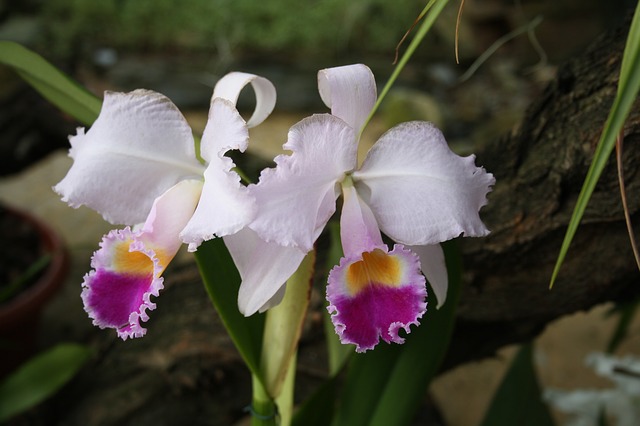
He described the process of what went into collecting one species from a particular place in Colombia. To reach the area where the orchids were, one had to first travel by mule for ten days into the jungle.
Reaching the spot, explorers then had to meet with local chiefs and work out a deal. Once the two parties came to an agreement, 20-100 natives would be hired as labour to cut down all the trees containing the orchids, with each tree holding possibly five plants.
Once you had gotten your hands on the orchids, your work was still far from done. It could be argued that getting the orchids was the easy part; getting them back to Europe alive was the tricky bit.
According to Boyle, one nurseryman is said to have “hugged himself with delight” when, out of 40,000 orchids, only 3,000 survived. Nurserymen without such luck were said to be ruined when only a handful of orchids arrived safely.

Maybe this ship is off to get some orchids?
Fortunately you won’t have to mortgage your house or travel to the jungles of South America to get your hands on a beautiful orchid. That said, many new orchid species remain undiscovered and modern explorers find more new species than scientists.
It’s not uncommon for a scientist to find a previously undiscovered orchid at the Singapore orchid market. National Geographic wrote a great article about how this can cause problems because orchids are fragile in their environment and depleting natural stocks can kill them off for good.
In the following chapters you’ll learn where and how to buy your orchids so you don’t contribute to the extinction of rare orchid species.
Now that we’ve had a look at the history of orchids it’s time to develop a better understanding of what orchids really are and how they work.
Part 2: Orchids 101
What are orchids anyway?
Now it’s time to develop an understanding of what an orchid actually is and why they’re so valued by people all around the world.
It’s thought that orchids have been on Earth for a hundred million years or so. In that time orchids have been very successful at spreading themselves across the planet.
They’ve been so successful that the orchid family makes up the second largest family by number of species of any flowering plants on Earth. As of now there are around 28,000 accepted species and since more are found each year, the real number of species is likely to be quite a lot higher.
While orchids are most frequently found in the tropics, they are found in just about every habitat on Earth.
Certain species are found within the arctic circle and two species have even been found on a small island halfway between New Zealand and Antarctica.

Macquarie Island; if orchids can grow here then they can grow just about anywhere
Having evolved to survive in different environments means that orchids vary a lot in their appearance. It’s for this reason that most people find it harder to picture “an orchid” than they would a rose or daffodil.
That said, once you know what you’re looking at, the differences between orchids and other sorts of flowers are quite stark.
Orchid Anatomy
Despite the wide variety of orchids that exist, orchids are always made up of the same essential parts. Most of these are common to all flowering plants, but not all.
The main difference is in what is called the column. Most flowering plants have separate male and female parts, respectively called the anther and stigma.
Orchids, however, have a column in which the male and female parts are fused together.
In addition to the column, orchids typically have three sepals and petals. The middle petal, called the lip, is usually quite different from the other two and serves as a landing pad for the pollinator.

Orchid Pollination
Pollination is a vital part of the life cycle of any plant. In this process, a pollinator takes pollen from the male part of one plant and deposits it on the female part of another plant. The pollinator that is easiest to bring to mind is the humble bee.
Most plants are happy to be serviced by just about any pollinator, but because orchids have evolved in various places and environments, they have also developed specific and often quite interesting methods of pollination.
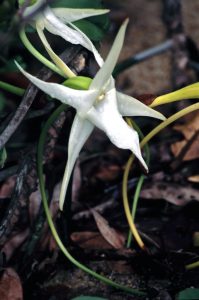
An example of Darwin’s Orchid (Angraecum sesquipedale)
To attract pollinators, a plant must offer them something of interest. Orchids typically use nectar to attract their pollinators, but some use fragrance, shape and even colour. Orchids that are pollinated by moths typically release a chemical at night since moths typically fly around at night time.
Other species that are pollinated by flies emit an odour that resembles rotting meat.
Another species only found living underground in Australia has evolved to be pollinated by ants.
Perhaps the most famous example of orchid pollination comes from Charles Darwin. Darwin was the first person to document the pollination process of orchids and upon seeing a long flowered orchid (later named Darwin’s Orchid), predicted that it must be pollinated by a moth with an unusually long proboscis.
He was ridiculed for the longest time, but some years after his death, a moth with an unusually long proboscis was found.
You can read about more interesting ways that orchids attract pollinators in this article from the Brooklyn Botanical Garden: Orchids and their Pollinators
Categories of Orchids
While there are thousands of species of orchids, they’re typically put in one of two categories; epiphytes and terrestrials. This section will help you understand the differences.
Unlike most other plants, many orchids grow on trees rather than the ground. These orchids are known as epiphytes and while many people assume that they are parasites, this is incorrect.
They might grow on trees but they don’t feed off the tree. Epiphytes also have thick roots that are covered in a substance called velamen that allows the plant to absorb moisture from the air.

An epiphyte orchid clinging to a tree in the Singapore National Garden
The second category of orchids are known as terrestrials. These orchids grow in the ground (and some, known as semiterrestrials grow on the ground) and have quite hairy roots.

Botany Basics & Orchid Taxonomy
With tens of thousands of different orchid species located all around the world it won’t come as a surprise that if you’re going to enter the world of orchid growing then you’ll also want to familiarise yourself with the basics of how botanists organise and categorise orchids.
If it’s been a while since your last high school biology course, then this will serve as a quick refresh. You certainly don’t need to be an expert or memorise huge lists of species, but it helps to at least know some of the lingo.
All orchids belong to the family Orchidaceae.
This family is divided into five subfamilies.
These subfamilies are then further divided into tribes…
…which are in turn divided into subtribes.
Subtribes are divided into genera, which are finally divided into subgenera.
(Although some subgenera are actually divided into sections)
According to American botanist Robert Dressler, there are:
- 5 subfamilies
- 22 tribes
- 70 subtribes
- 850 genera
If you would like to learn more about orchid taxonomy, here are some other guides you might find useful:
Taxonomy of the Orchidaceae by Wikipedia – A little dry but solid information
Integrated Taxonomic Information System – Authoritative taxonomic information from the US government
Taxonomy & Diversity of Orchidaceae – Lengthy video (28 minutes) from the University of Kashmir
Taxonomy: Life’s Filing System – Quick video on the basics of taxonomy from the guys at Crash Course
Orchid Species & Hybrid Nomenclature
One daunting part of becoming an orchid enthusiast is getting your head around the naming conventions. With 28,000 different species, you can imagine how confusing things would get without a consistent naming system, which is why most orchids are given scientific names.
And while Latin may be considered a dead language to some, it certainly is alive and kicking among the sciences.
Orchids that have been created by mother nature are known as species orchids. Species orchids have two names, like you probably do. The genus name always comes first and is followed by the species name.

Because they’re Latin names, they’re typically italicised and the genus name only is capitalised.
You’ll see that some orchids have a third part to their name. This is known as the botanical variety and is given to an orchid that differs from the species in some dimension. You’ll know you’re looking at a variety when you see the main name followed by .var and another name.
Here is an example:
Dendrobium phalaenopsis
Naming species orchids can be tricky enough to a beginner, but naming orchids gets a little trickier when it comes to the man-made orchids known as hybrids.
Hybrid orchids are created when the pollen of one orchid is taken and used to ‘mate’ with another. The resulting orchid is often a superior product to the original, which makes them very popular in the orchid growing world.
The resulting names might not be superior, but they are a little different to their parent orchids.
An example is:
Phragmipedium Eric Young (besseae x longifolium)
This hybrid orchid comes from the genus Phragmipedium, it is a hybrid named “Eric Young” and it’s the result of a cross between the besseae and longifolium species.
Hybrids excite growers for another reason too; if you’re the first person to cross two particular species then you have the honour of naming the resulting orchid. This process will be covered later in this guide.
Common Types of Orchids to Grow
As much as we’d love to have 28,000 pictures of all the different orchids, it’s not really practical. Instead, we’ve listed below eight of the most popular orchids. These are the orchids you’re most likely to come across in your orchid growing journey.
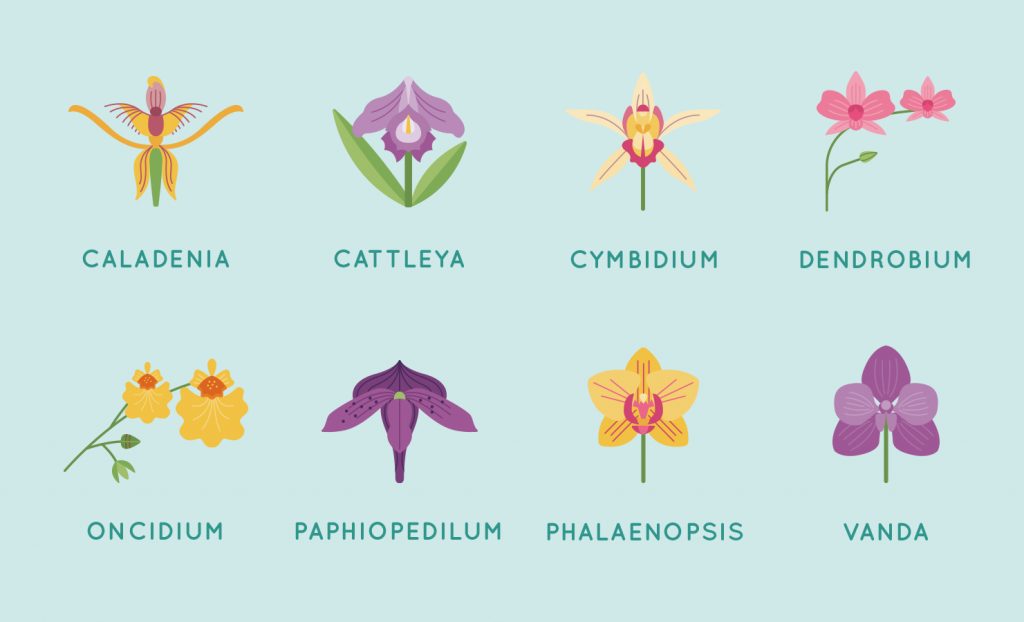
To learn more about the species below, learn how to pronounce them correctly and to see more high quality photos, click the links below to view the “All About Orchids” page from the American Orchid Society:
- Cattleya
- Dendrobium
- Oncidium
- Paphiopedilum
- Phalaenopsis
- Vanda or Singapore orchid
- Cymbidium
- Caladenia
Orchid Glossary
As mentioned earlier, one of the intimidating parts of growing orchids is the vocabulary you need to pick up (at least if you want to sound like you know what you’re talking about!). To get up to speed so you can converse with growers new and old, you can always read through and bookmark a good glossary.
We like this one put together by Taisuco America: Glossary of Orchid Terms
Part 3: Growing Your First Orchid
Now that you’re acquainted with the history of orchids and you understand the fundamentals, it’s time to get your hands on your first orchid and put some of that theory to the test!
There are a few important considerations to make before you do this, however, so make sure you read through this chapter before going out and purchasing your first orchid. It will save you money, time and effort.
The first is to decide on where you’re going to buy your first orchid from. With orchids being popular these days, there’s no shortage of options and some are better than others.
If you are serious about growing orchids, then you’ll probably want to avoid the ones at hardware stores or general nurseries. There are some exceptions, but generally these orchids aren’t as high quality as you’ll be after and are aimed at people who just enjoy having them in their environment.

Orchid clubs not only serve as a great place to learn and mingle with people who share your passion, but they’re also great sources of quality orchids. If you’re serious about growing orchids then you’ll probably join a club sooner or later, so when you do, ask around and one of the more knowledgeable members will be able to help you out.
Orchid shows are another great source of high quality orchids. It makes sense to buy them where the best examples are being shown. The downside to this is that shows aren’t on all the time, so if you’re in a hurry you’ll want another option.
Buying from shows is great and getting them from a trusted source at a club will also work, but if you’re in a hurry to get your hands on an orchid as quickly as possible, a third option is to try a specialist orchid supplier. Not only will they be able to supply you with the orchid you’re after, but you’ll be able to get your hands on them quickly.
Next up you need to carefully consider the environment where you’ll be keeping your orchids. Because orchids are from all over the planet and have adapted to just about any environment, they can be a bit particular about where they like to live.
Firstly understand the temperature and humidity. There’s a Goldilocks zone for most orchids and you’ll want to be sure you get an orchid that likes the temperature you’re going to place it in.
Here are some links to hardiness zones that will help you determine which zone you live in:
Australia Plant Hardiness Zones
United States Plant Hardiness Zones

Next you’ll want to consider the space you have available. Orchids grow in a wide variety of shapes and sizes, so you’ll want to make sure that you match the space available with the right orchid.
Another important factor is getting the right light. Orchids are also particular about how much light they get. If you get this wrong your orchid won’t flower and you’ll end up frustrated. To figure out how much light is in your environment, use the shadow test.
Here’s an explanation from the American Society of Orchids.
And here’s a list from the Wagga Wagga Orchid Society of various orchids and their preferred light requirements:
The final dimension to consider is when you want your orchid to bloom. Different orchids have different blooming cycles, so you’ll want to make sure you get something that blooms when you want. If you want long blooming orchids but end up with one that only blooms once in a blue moon you’re going to end up a little bit frustrated.
Here’s a good guide by Ryan Levesque on the blooming cycles of several popular orchids:

Once you have your heart set on a particular species of orchid, it will be time to select your first plant. If you’re following our advice and buying one from specialist suppliers or friends at a club then you should be guaranteed a high quality plant, but it helps to understand what separates a good plant from a great one.
Not only will they look better, but they are more forgiving and have a better chance of survival.
Here are a few recommended guides to help you learn this process:
How to Select a Healthy Orchid from the Store by Just Add Ice Orchids*
How to Choose a Healthy Orchid from the Store by Brad’s Greenhouse
How to Select a Good Orchid by the Chicago Botanical Garden
*The above guide is a good guide, but you shouldn’t add ice to your orchids! (See the FAQ for why!)
Part 4: Tools of the Trade
If you’re serious about growing orchids, you’ll need some tools to help make your work as easy as possible. Some tools are considered must haves, while others are luxuries for people who are as serious about orchids as you can get.
Pruners

If you only buy one tool make sure it’s a pruner. Whether it’s to trim the leaves or to cut through a stem, you’ll find yourself using your pruners more often than anything else.
As with all tools, you can buy a cheap set of pruners or you can spend quite a lot. There’s generally not a huge difference these days with a lot of cheaper ones working quite well, so if you’re on a budget you don’t have to worry.
Scissors

If you find yourself doing cutting work that your pruners are just a bit awkward for, then you’ll want to get your hands on some scissors. Some orchid growers find that a single pair of pruners works fine, but if you’d like to be able to cut with more finesse, then scissors could be the thing for you.
Some orchid enthusiasts insist on using scissors made especially for flower work. And while there’s nothing wrong with using them, you can get away with a decent pair of scissors if you’d prefer to keep things simple as well.
Sterilisers
When you’re using any of the cutting tools, whether they be scissors or secateurs, you want to make sure that the tools are sterile. You don’t want to kill one of your orchids because an infection spread from your tool.
There are several ways to do this. Some people use a handheld lighter, others prefer to use rubbing alcohol and some hardcore orchid growers go as far as to buy a small, hand held blow torch.
Watering Can

As with any plant, orchids need to be watered too and this is best done with a watering can. When choosing a watering can, you want to make sure that it has a spout that is not only long enough to reach all of your orchids, but also has a water breaker.
This ensures that the water doesn’t come out of the can in a powerful torrent, which would wash away the potting mix.
Garden Hose

If you prefer to water with a hose, then you’ll want to make sure you buy a good quality one. These are less likely to kink and cause you problems. And as with the watering can, you’ll want to make sure you attach a water breaker to it so that the stream isn’t too powerful.
Spray Bottle

While not essential, a spray bottle can be used to increase humidity or to clean the leaves of your orchids. You probably already have one of these lying around your house somewhere, but if you don’t then a regular one will do.
Thermometer

Orchids tend to be particular about temperature (as you’ll learn in the next chapter) and so monitoring the temperature where your orchids are is important, especially if you’re in a place where the temperature fluctuates quite a lot (Melbourne, I’m talking about you).
A simple wall thermometer will do the job, but orchid enthusiasts have been known to go to great lengths to monitor their temperatures and install sensors in several different areas of their homes in order to better understand the environment their orchids grow in.
Part 5: Orchid Growing Mastery
By now you should understand how to get your first orchid and what tools you need. This means you’re finally ready to look at how to grow orchids and avoid killing them (which is easier said than done).
Orchids have a reputation for being difficult to grow, but if you master a few basics then you’ll find them more forgiving than you might expect. In this chapter you’ll learn how to master the fundamentals of growing orchids.
Lighting
Light is important for any plant because of photosynthesis. However, getting lighting right when you’re growing orchids is particularly important because not all orchids like the same amount of light.
Hopefully you’ve already followed our instructions earlier on and figured out how strong the light where you plan on growing your orchids.
From this you should be able to figure out which orchids are appropriate for your space. For future reference there’s a quick rule of thumb that you can use to quickly judge what sort of light an orchid prefers.
Orchids that prefer high amounts of light typically have thicker and more robust looking leaves.
Orchids that prefer lower amounts of light typically look softer and less robust.

Vanda orchids love lots of light, as you can tell by their leaves
Once you start to grow your orchids they’ll tell you how much they like their lighting conditions. If you know how to listen to these signals you’ll be able to adjust them if they’re not ideal.
When they’re happy, their leaves will be nice and green. Their shape will also be similar to the rest. And the plant will have a certain strength to it; it will look healthy and robust. And perhaps most importantly, they’ll be happy to bloom for you.
When an orchid fails to get enough light, it won’t be able to bloom. If an orchid gets too much light, the leaves will have a yellowish tinge to them and will likely look a little burnt and unhealthy. Just as with people, orchids can get sunburnt, so you have to take care.
If you’re finding it hard to get the lighting right for the orchids you want to grow, then you have a couple of options. You can setup your own set of fluorescent lights or look at setting up your own greenhouse.
Here’s a setup by YouTuber Miss Orchid Girl:
And here are three more links you might find useful:
Orchids Made Easy guide: http://www.orchidsmadeeasy.com/growing-orchids-under-lights/
Garden & Greenhouse: https://www.gardenandgreenhouse.net/articles/november-december-2012/creating-an-orchid-greenhouse/
American Orchid Society: http://www.aos.org/orchids/additional-resources/greenhouses.aspx
Humidity
Another important factor to control when growing orchids is humidity. Because the majority of orchids that people want to grow originated in the tropics, the humidity required is typically higher than most people living in temperate climates can manage.
If you’re not living in North Queensland or the Top End, then this can be a problem. Low humidity levels will damage the plant and stop them from reaching their potential.
One solution is to be more particular about which orchids to grow, but if you have your heart set on growing certain tropical species then there are a couple of solutions.
The first is somewhat labour intensive, but depending on your level of dedication may be worth it. By misting the air around your orchids with a water bottle several times a day (depending on the level of humidity in your environment) you can artificially raise the humidity where your orchids are growing.
Another option that requires much less effort is to use a room humidifier. These work by blowing air across a wet pad that sits in a pool of water.

Temperature
Since most species of orchids evolved in particular environments, most of them are a little picky when it comes to the temperature they live in. While most are robust enough to survive a wide range of temperatures, if you want to grow them to be as beautiful as possible then you’ll want to make sure you grow orchids in a temperature range that suits them well.
If your environment is too cool for the orchid, growth will slow and flowering becomes less likely. In some situations the bulbs even fall off.
If your environment is too hot for the orchid, they will respond by slowing their growth as well, but they may also begin to wilt and shrivel up.
What you need to do to ensure that your orchids are kept at the correct temperature depends on your climate and your orchid.
Here are a couple of links you might find useful:
http://everything-orchids.com/orchid-care/orchid-temperature
http://www.orchidcarelady.com/orchid-care-and-maintenance-tips-temperatures-for-orchids-part-i/
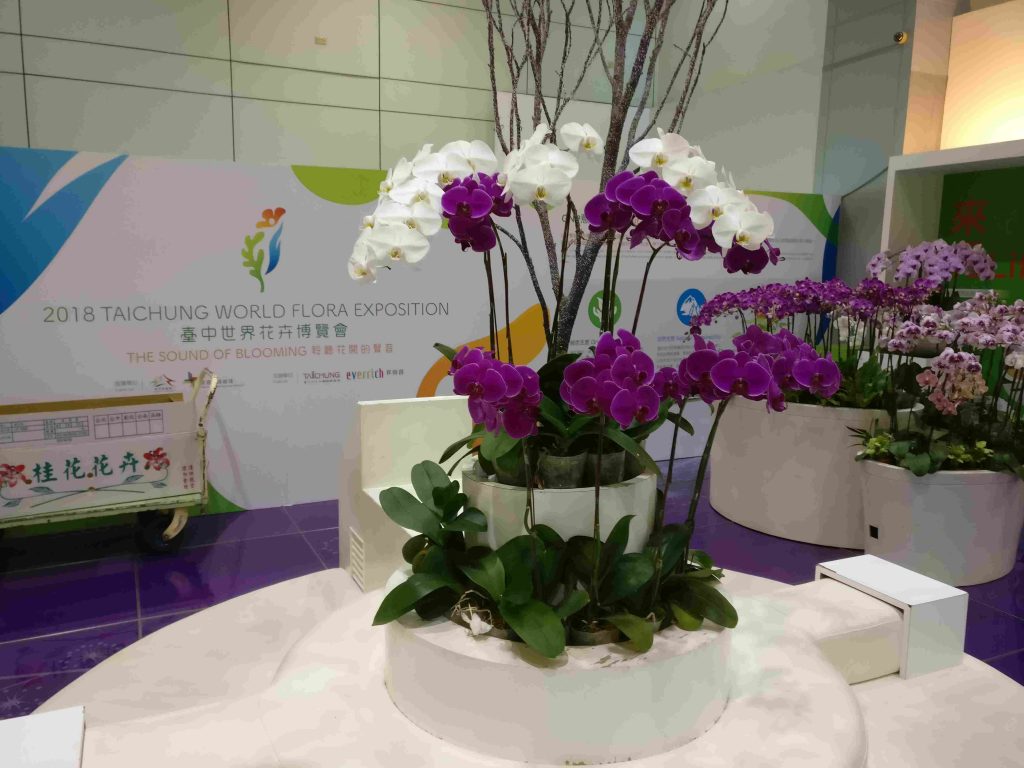
Ventilation
In most of the environments that orchids grow in organically, air flow is present. Therefore if you want to grow these orchids successfully in your own environment you’ll need to provide them with similar air flow.
Fans do a good job of this and are an inexpensive way to ensure that your orchids get enough air flow.

Watering
Watering might seem like a simple task, but making mistakes here is very common amongst newer growers. It would be nice to give you a quick rule of thumb for how and when to water your orchids but the truth is that it’s a little more complex.
The first variable to consider is the type of pot your orchid grows in. Plastic pots do not allow the soil to breathe, so it will tend to dry from the top down. Clay pots do allow the soil to breath so water will evaporate from all levels of the pot. This means that if you’re using a clay pot you’ll need to water more often than if you’re using a plastic pot.
Which pot you use depends on the type of orchid; orchids that prefer to be wetter are best grown in plastic pots, while those that can tolerate dryness better might be best grown in clay pots. You always want to give yourself the largest margin of error possible.
The potting material also affects how often you’ll need to water your orchids. This is mostly determined by how well your potting material absorbs water.
Potting materials tutorial:
Orchid Whisperer Orchid watering tutorial:
Really good tutorial on potting mix and materials from Dummies
Dummies guide to diagnosing watering problems
Fertilising
Fertilisers are useful when growing orchids but they’re not to be thought of as a crutch, something to lean on. If you’re having trouble growing orchids then you need to refine your technique and figure out where you’re going wrong.
But if you’re already growing lovely orchids then using fertilisers can make the process even better.
Here’s a guide from Orchids USA: http://www.orchidsusa.com/6fertilizing.htm
Repotting
From time to time you’ll need to repot your orchids. Many people are anxious about this, but if you know what you’re doing it’s not anything to fear.
It can be a little bit of work, so here’s a good tutorial from the Chicago Botanical Garden:
Propagating Your own Orchids
If you start to really become interested in orchids you’ll probably want to grow more of them. One difficulty in doing this is that orchids tend to be slow growing. Growing an orchid to maturity can take several years, so if you’re not that patient you might want to look into propagating your own orchids. This topic could have a guide all to itself, so if you want to know more about it, here’s a good guide from Classy Flowers.
How to Make 100 Orchids from 1:
Getting your Orchids to Bloom and Re-bloom
Once your orchids are growing, making sure that they bloom and re-bloom is always something you’l want to know. As with many other topics, this is a little beyond the scope of this guide, but here’s a ten minute video from Shirley Bovshow that explains how to do it:
3 Quick Tips from Expert Orchid Growers
We reached out to some of the top orchid growers in Australia and three people were generous enough to send us some tips to add to our guide.
Bill Dobson: That’s a hard one as there are different requirements for the different species and genera. To start with you have to have good genetic material as awards come from good stock. So if you have the plants then the material they are planted in will depend on your local environment as it can be more open or water retentive.
Basic orchid culture requires the correct combinations of the following; Light, the right amount of sunlight so that your leaves are not too green and not too yellow. If you get the light right then Air movement is the next element as this will help the plant breath and will prevent diseases and fungal problems. Water is the third element and the more of the first 2 will allow for for water and with the water all you to feed with a good fertiliser that is not too high in nitrogen.
So as you can see it’s simple and not so at the same time.
Craig Scott-Harden: The orchid will tell you if it is happy or otherwise by careful observation, this is something that seems obvious but is really only learnt over a period of time!
Join an Orchid Society. They are fun, you can learn so much from other growers and from guest speakers. Every month they have a benching and generally a couple shows each year! And for about $20.00 a year you can get a night out with like minded friends and enjoy a cuppa and a chat!!!
Jody Cutajar: The one most relevant tip I can give to a new grower is that Killing with kindness is a reality! Over watering kills more orchids than everything else put together!
Part 6: Pests & Diseases
Humans aren’t the only creatures on Earth than find orchids attractive. Unfortunately, various pests and diseases also happen to like orchids. They can be a bother, so in this chapter we’ll look at how to prevent them from infecting your orchids to begin with, how to notice when they have and finally how to get rid of them if the worst happens.
Prevention
A lot of the common problems faced by orchid growers can be prevented by using some best practices. The first thing you should get into the habit of doing is to ensure that your tools are sterile any time they touch an orchid.
There are a couple of ways of doing this. Some people like to use a cigarette lighter on the tool, while others prefer bleach. Some hardcore orchid lovers even go as far as using a handheld torch, like the ones you might find in a professional kitchen.
Even if your tools are safe to use, bugs can still take hold. It’s important that you frequently inspect your orchids for signs of bugs, because once they get hold it is much harder to get rid of them. Catching them early is the best way to make sure they don’t ruin your plants.
Common Bugs
Here are a few of the different sorts of bugs you can expect to find on your orchids at one point or another.
Aphids

Thrips

Scale

Spider Mites
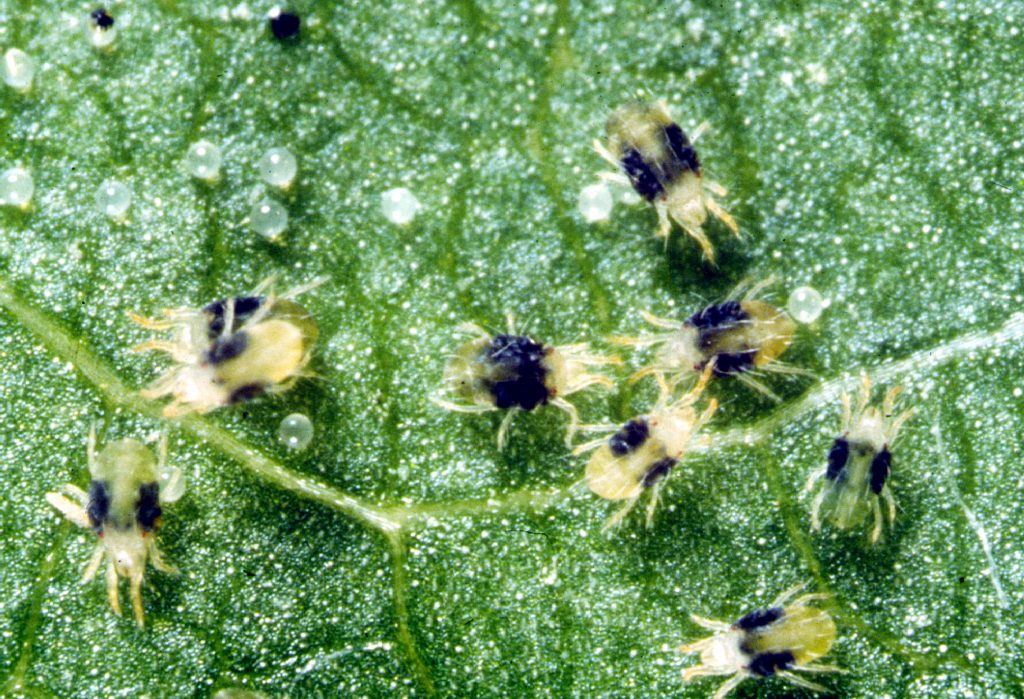
Slugs & Snails

Pest Control
When it comes to controlling the pests on your orchids, you always want to take the option that is least likely to damage your plants. Sometimes you won’t have a choice and you’ll be forced to use chemicals, but save those methods for when it’s absolutely necessary.
If you’d like to learn more about pest control in advance, Dummies has a great guide online.
Diseases, Viruses & Fungi
While bugs are the most common type of problem you’ll have to deal with, diseases can also affect orchids. And while bugs are usually easy to spot, viruses, bacteria and fungi can’t really be seen until the damage is done.
If you follow the sterilisation advice from earlier then you’ll be doing everything you can to prevent a nasty disease from taking hold, but from time to time things do happen. If this happens to you, apply a fungicide or bactericide and with some luck your orchid will be as good as new.
For more information, check out the guide by Gardening Know How.
Part 7: Advanced Topics
If you master the material covered so far then you’ll be sure to grow plenty of beautiful orchids. And if you’re like most people, you’ll probably stop at this point (at least for now).
However, some people really fall in love with orchids and want to learn as much as they can. In this chapter we’ll touch on a few of the topics that a serious grower would want to know, as well as providing links out to plenty of good tutorials that explain the topics in more detail.
So whether you’re already hooked or think you might be in the future, the following is a taste of what you might end up spending your time on.
Growing your Collection
When you’re just starting out with your orchids, you’re happy when any of them grow and bloom at all. Over time your collection of orchids will grow as you start to become skilled at growing.
At some point though, you may want to stop thinking about individual orchids and start thinking about the overall collection.
When you reach this point, think about what you would like your collection to look like, consider where it’s at now and then work diligently towards bridging the gap.
What orchids do you want making up your collection?
When do you want them to bloom?
Do you want to try adding something new to the mix?
What about creating your own hybrid?
Reaching this stage is an interesting place to be at and if you’d like to know more about this, then check out the article by Hans Proebsting from the Orchid Societies Council of Victoria.

Creating your own Hybrids
Another area of interest for serious growers of orchids is to create your own hybrid. Even though there are tens of thousands of species orchids in the wild, humans have created hundreds of thousands of different hybrid species.
It can be a fun process and creating something that has never been done before comes with the honour of being able to name it yourself, so let’s walk you through the process.
Just as with people, when you breed two different orchids the resulting hybrid has traits from both parents.
If you want to be able to name your hybrid, you’ll need to make sure that it has never been seen before. With hundreds of thousands of hybrids already created, it can be hard to figure this out on your own, so one of your first steps should be to check with the Royal Botanical Society:
The International Orchid Register
Once you’ve decided to create your own hybrid, the next step is to cross-pollinate the two parent orchids. This is actually quite simple and the following video demonstrates exactly how to do it:
Once you’ve completed this step, the next few steps involve some patience, as this guide explains:
How to Create your own Hybrid and name it
Orchid Shows & Winning Awards
Another facet of growing orchids that fascinates many keen orchid growers is to get involved with showing orchids and winning awards.
Exactly how winners are chosen varies somewhat, but the principles are all quite similar. The guidelines we’ve mentioned below have been taken from the Orchid Societies Council of Victoria’s Judging Handbook.
According to the handbook, there are four main areas that judges look at in order to select award winning orchids.
Shape and substance is the first. Here judges look at the shape and form of the orchid. Orchids will win points for being zygomorphic (meaning that the flower is symmetrical if you draw a vertical line down the middle of it).
The flower should be robust enough that it maintains its shape on its own. An orchid that droops, twists or flops around isn’t desirable.
Next the judges will consider the colour and texture of the orchid. The colours should be consistently distributed throughout the flower and not contain any blemishes.
What judges call habit & arrangement is another criterion and refers to how well the stem of the orchid supports the flower without excessive staking. If the orchid is bent over or twisted in some way, that is considered less than ideal.
Finally, the judges will look at the size of the flower, which should be appropriate to the species.

If you’re lucky enough to have your orchid deemed a winner, then you’ll receive one of the following awards (in Victoria at least):
First Class Certificate (FCC): Must receive > 85%
Award of Merit (AM): Must receive > 80%
Highly Commended Certificate (HCC): Must receive > 75%
Award of Distinction (AD): Awarded to recognise outstanding quality such as colour, size, etc
Certificate of Botanical Merit (CBM): Award conferred only once for a species or natural hybrid that is rare in cultivation
Cultural Certificate (CC): Available to a grower whose orchid is clearly superior in flowering, size or robustness, than what you would expect.
Award of Quality (AQ): Available for a group of at least five siblings of one grex raised from a single seed by same grower and shown together. Have a picture of past winner.
Part 8: Frequently Asked Questions
As with any complicated topic, there are certain questions that crop up time and time again. We’ve used some online research tools to find out what these questions are and if we haven’t addressed them in the guide we have addressed them below.
Q: Where do orchids grow naturally?
A: While most orchids are found in the tropics, you can also find orchids in just about every environment on Earth. Some species are even found in the arctic, meaning that Antarctica is the only place where you won’t find orchids growing naturally.
Q: Will orchids kill cats?
A: While orchids aren’t deadly to cats, they can make them feel sick, so it’s best to keep your cat away from orchids if possible. Lilies on the other hand are definitely something you need to be aware of.
Q: What do orchids symbolise?
A: Because orchids exist all around the world, they also have varying meanings to different peoples. In ancient Greece they were associated with virility, and in Victorian times they were so hard to come by that they were seen as status symbols.
Q: What orchid has a monkey face?
A: Unsurprisingly, this orchid is commonly called the Monkey Face orchid, but has a scientific name of Dracula simia and appears at #1 on our list of the 40 weirdest flowers.
Q: What orchids are edible?
A: The flowers of most orchids are safe to eat, but there are a few that can cause an upset stomach. The vanilla bean is actually part of the fruit of an orchid.
Q: What orchids have a scent?
A: Quite a few! Because some orchids attract pollinators with scents and what pollinator they use depends on their environment, orchids have a wide variety of scents. You can read more about some of the more common scents here.
Q: Are orchids parasites?
A: No. While this is a common misconception due to epiphytic orchids growing on trees, they do not feed off their host tree; it’s merely a place for them to live.
Q: How do orchids pollinate?
A: There are lots of ways that orchids pollinate, we’ve covered it in some detail in part 2.
Q: What orchids are easy to grow?
A: Orchids aren’t as tricky to grow as many people think, but below we’ve listed five orchids that are the easiest to grow:
- Moth Orchids
- Dendrobiums
- Cymbidiums
- Oncidiums
- Cattleya Orchids
Q: Which orchids last the longest?
A: If you treat your orchids right then there’s no reason why your plant won’t survive for many years.
Q: How often do orchids bloom?
A: The truth is that it varies from species to species. Many bloom once or twice per year and how long they bloom for varies as well. Some will bloom for just a few short days, while others can be in flower for a few months. Phalaenopsis orchids are an example of an orchid that blooms for quite a long time, with a couple of months being normal.
Q: Can you grow orchids indoors?
A: Yes you can grow orchids indoors. As we’ve outlined in the guide, successfully growing orchids depends on a few factors such as temperature, humidity, lighting and ventilation. If you get these sorted then you can grow orchids just about anywhere. The main difference is in how those factors change when you bring orchids indoors. What was a great environment outside may not be great inside.
Q: Why do my orchids keep dying?
A: There are lots of ways that you can kill your orchids. If you’re following the best practices set out in the guide above then you should be ok most of the time (everyone loses an orchid now and then) but if you are doing everything you can and your orchids are still dying at a high rate, then there are a few things you should check. Are you watering correctly? Have you got the conditions right for your particular type of orchid? Getting any of these wrong can kill your plant.
Q: Will orchids grow in potting soil?
A: It really depends on the type of orchid you want to grow. The first thing you need to check is whether your orchid is an epiphyte or a terrestrial. If it’s an epiphyte, then you should know that these orchids are often found growing on trees, so they don’t need any potting mix. If your orchid is a terrestrial then you’ll want to check the guide above to figure out what soil you need.
Q: Will orchids grow from cuttings?
A: Again this is not a simple question to answer. Some orchids are possible to grow from cuttings, while others are not.
Q: Can orchids grow outside?
A: Seeing that orchids have been growing outside for millions of years, they most certainly can. The key is to select orchids that are suited to your environment, or making your environment one that suits the orchid you want to grow. If you do this then you can grow orchids just about anywhere.
Q: Can orchids live in water?
A: Yes, orchids can live in water. You do need to be sure that the water you used isn’t full of harsh chemicals, but many orchid growers use water to grow orchids. Some people like to grow them in glass containers so they can see the orchid growing all the time.
Q: Which orchids are epiphytic?
A: Epiphytic orchids are those that grow on other plants and trees. They differ from terrestrial orchids in that their roots are covered in a substance called velamen, which allows them to absorb moisture from the air rather than from soil. Despite popular belief, they aren’t parasites and simply use the plant as a place to live; they do not feed off of it.
Q: Which orchids are terrestrial?
A: Terrestrial orchids are those than grow in the ground. These type of orchids are more readily understood because they look and behave like more regular plants; that is they grow in the ground where they get their nutrients from the soil they live in.
Q: Which orchids have pseudobulbs?
A: Quite a few species of orchids have pseudobulbs. Some of them include Cattleya, Dendrobium, Laelia, Oncidium and Epidendrum.
Q: Can you use ice cubes to water orchids?
A: You can, but you probably shouldn’t. The idea behind this seems to stem from the fear of overwatering your orchid. That if you simply place an ice cube next to your orchid then you won’t overwater your orchid. This is true, but the logic doesn’t really hold since most orchids are from the tropics. Ice cubes also fail to provide the humid environment that more solid watering provides. In short, don’t use ice cubes to water your orchids.
Q: Why do orchids wilt?
A: Unfortunately, orchids wilting is a natural part of their life cycle. After an orchids blooms, it will start to wilt. If you’re bothered by the wilting leaves you can always snip them off yourself.
Part 9: Recommended Resources
If you’ve gone through this guide in its entirety then you should be well on your way to becoming a master orchid grower.
That said, there’s still a huge amount of information that was beyond the scope of this guide. And while in days gone by the problem facing people wanting to learn was simply finding sources of information, nowadays the problem is different.
If you want to know more about orchid culture it can be hard finding reliable sources. So we’ve scoured the web for the best of the best and have featured them here for you.
Orchids Clubs & Societies
If you’re serious about learning more about orchids, one of the best moves you can make is to join a local club or society. Here you’ll meet like-minded people who will be able to give you advice specific to you and your goals.
For Australians, the Australian Orchid Council has a list of clubs by state on their website. If you’re in Sydney, we’ve heard great things about the Western Suburbs Orchid Society.
If you’re in the US, the American Orchid Society is a good place to start. Chances are you’ll find clubs closer to home though too.
If you’re in the UK, the Orchid Society of Great Britain should be able to point you in the right direction. Alternatively, check out the British Orchid Council.
Best Books on Orchids
This guide was written to help beginners figure out what they don’t know they don’t know. If you want to deepen your knowledge, then getting your hands on a couple of books is a great way.
There are plenty of books on orchids out there, but here are a couple of our favourites:
Complete Guide to Orchids by Ortho Books
The Orchid Whisperer by Bruce Rogers
Taylor’s Guide to Orchids by Judy White
YouTube Channels
We can’t really mention further educational opportunities without mentioning YouTube. There are new orchid videos being added there every day and keeping up can be tricky. So we’ve gone through as many as we could to find the best channels possible:
Web Forums
If you’re not the type to join a club in the real world, perhaps you’re more interested in joining a web forum. There are a few varieties these days; there are traditional web forums, Facebook groups and Subreddits. Below we’ve listed out some of the best ones for you:
The American Orchid Society Public Group (Facebook)
Conclusion
Ok, so that’s it for this guide on how to grow orchids for beginners. In it you’ve learned about the interesting history of how orchids were first grown in the west, you’ve learned the basics of what makes an orchid an orchid, how to go about selecting your first orchid, what tools you’ll need to do so, how to grow them and keep them safe from unwanted pests.
We want this guide to grow and evolve over time, so if you’ve got any suggestions for us, please leave them below in the comments section!
It doesn’t matter if you’re a newbie who wants something clarified, or an old hand who thinks we’ve missed something vital. If you’re passionate about orchids then we want to hear your thoughts, even if it’s just to tell us your favourite part of the guide.













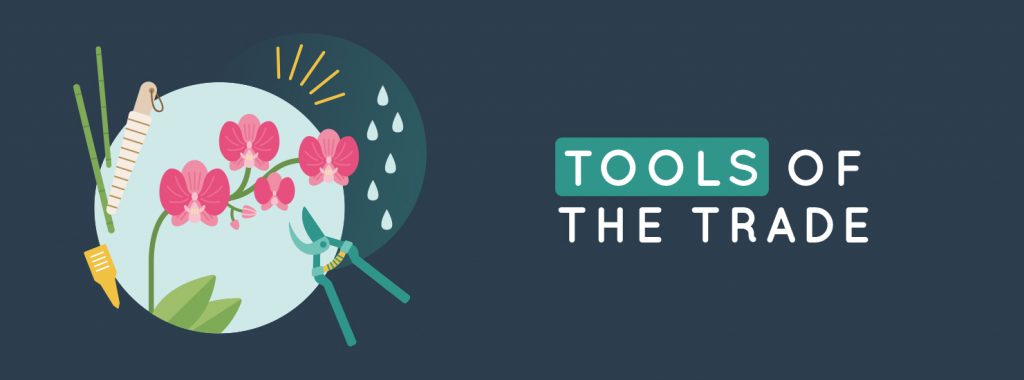








Leimok Theuil
October 22, 2019 at 3:51 pmiam a newbie.. i repotted keiki orchid and now is blooming with a different colour from the mother.. just love it
Susan Avery
October 17, 2020 at 3:25 amMy orchid has quite long roots growing out side the pot. When I repot should I trim them and try to squish them into the new pot and cover with soil?
What is the best potting mix please?
Sean
November 12, 2020 at 1:35 pmHi Susan,
I wouldn’t worry about the long roots unless they’re dead.
As for the potting mix, there are lots of options for orchids and there’s no single mix that’s right for everyone. You can find a list of the best ones to try out in the guide.
Cheers,
Sean